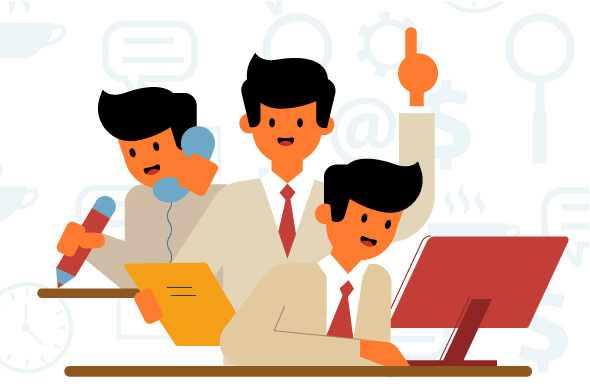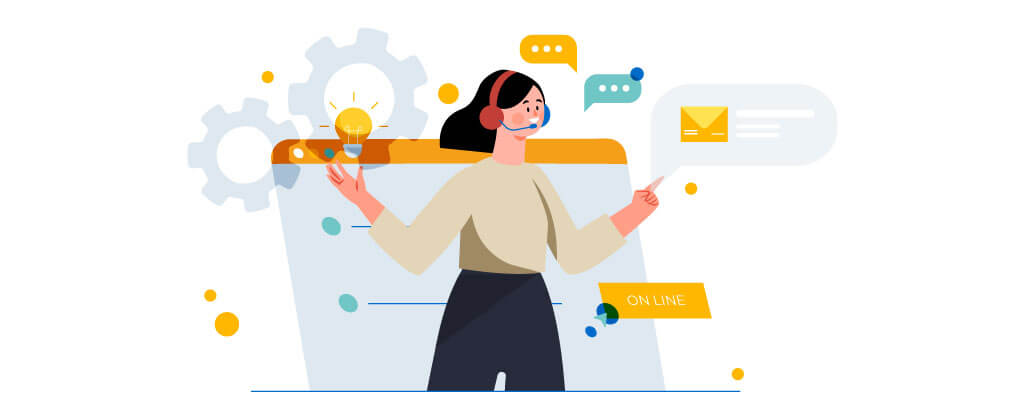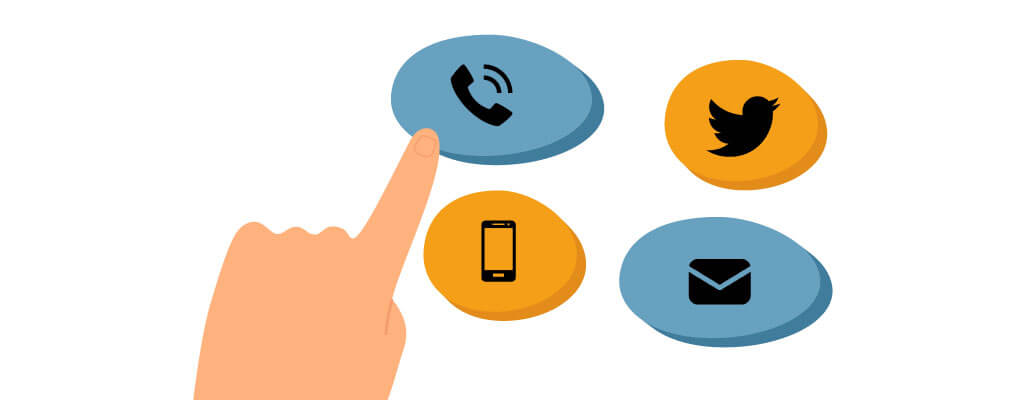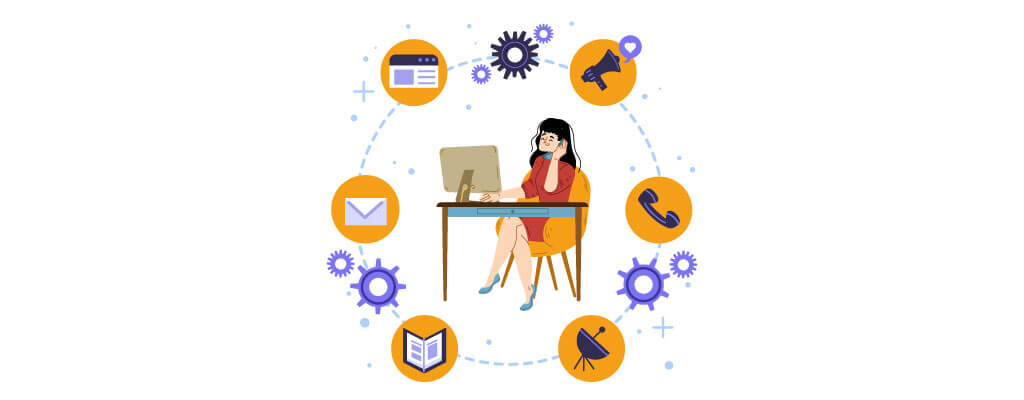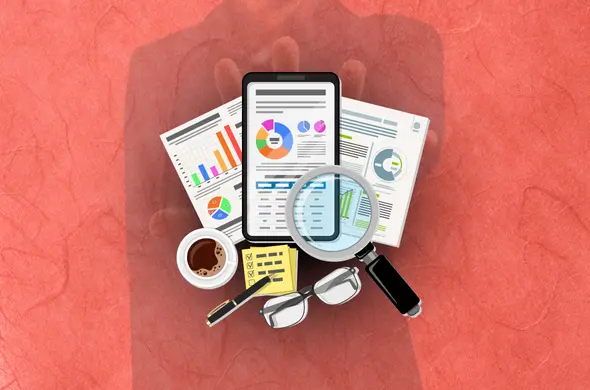Updated
May 3, 2023
Written by
Alyssa Maano
Nobody likes waiting in line. It is time-consuming, mind-numbing, and cuts into any chance of being productive. But it’s even more frustrating when the line cuts off before your turn or there is nothing resolved, right?
The same sentiment applies to customer service when waiting in a queue for an available customer service representative. It's even more aggravating when correspondence is restricted to a few channels, increasing the wait and decreasing the odds of a meaningful interaction.
The addition of other digital communication media changed both business standards and customer expectations. It is for these reasons that an evolution in brand-customer communication is ushered in, hence the development of customer contact centers.
What is a customer contact center? Let’s dive in!
A contact center is a central hub, either physical or virtual, from which customer interaction is managed across various channels. It handles a wide variety of communications, providing omnichannel support to its clients.
Call centers are usually included in contact centers, together with text chat, email, voice over Internet Protocol (VoIP), and website support. Should there be a need to switch channels, the agents can easily traverse from one channel to another to cater to the preferred mode of communication of customers.
What are the contact center services' key features?
While most often than not, contact centers and call centers seem almost interchangeable, there is a clear distinction between the two.
First, as previously mentioned, call centers can become subsets of contact centers. Second, while providing the same services as call centers, like fielding inbound calls and carrying out outbound calls, contact centers work over more channels besides the phone.
For a more in-depth discussion, you might want to read more on our blog about Contact Center vs Call Center!
Instead of a centralized approach to building a company or a business, more and more business owners are now opting to outsource to other companies that offer their resources as services. With the continued rise of SaaS (Software as a Service), it’s only a matter of time before contact centers follow.
Contact Center as a Service (CCaaS) is a cost-effective software deployment model that allows companies to purchase only the required technology. This option saves significant cost by omitting the need for implementation, setup, and IT maintenance.
CCaaS is also used to handle significant volumes of queries and provides access to their contact center solutions, which is a huge benefit for small organizations. Because the contact center is not physically tied to the company's site, renovations, location transfers, and the like have no effect on operations. As such, firms can more easily modify the scale of their offerings.
The CCaaS provider should have the following features:
However, not all contact centers offer the same services. The following is a list of some of the most prevalent types of contact centers.
An inbound contact center is the most fundamental type of contact center setup that exclusively or primarily caters to incoming phone calls. These phone calls contain customer issues like service questions, inbound sales inquiries, order fulfillment, and many others.
This type of contact channel is reactive in that the representatives wait for the calls to come to them, making this type ideal for customer service. The abundance of voice communication in customer support makes this type still high in demand.
In contrast to the inbound type, outbound contact centers use a more proactive stance. Companies use this when they need to engage with their customers. Instead of customer service, the agents are more focused on sales and marketing. Some examples include customer follow-ups, telemarketing, and cold calls.
Naturally, in these present times, it’s not enough to just be strictly inbound or outbound. A hybrid setup opens up more opportunities for customer engagement due to the holistic approach. It can come in two different types: multichannel and omnichannel.
What is a multichannel contact center? It is a type of contact center that focuses its communication on a limited number of channels.
What is an omnichannel contact center? Meanwhile, an omnichannel contact center covers all available channels. In addition, customer information is carried over from other channels, allowing more seamless communication and minimizing the repetition of questions and answers.
With the number of personnel, tasks, and information in a contact center, certain technologies are needed in order to maintain the fluidity of operations. Here are some of the most prevalent technologies used by contact centers:
This is a telephony system that automatically receives and distributes incoming calls to an available agent. This technology helps avoid overwhelming the team and decreases queue wait time by making sure the customer is connected to a representative as soon as possible.
Intelligent Call Routing is similar to ACD but with more enhanced call routing capabilities. It identifies the clients and sorts them according to the available information. Then they are routed to the appropriate agent based on the specific instructions and how the call is to be handled.
This system is like Intelligent Call Routing but for emails. It monitors email activity by receiving, analyzing, sorting, and then routing it to the designated receivers and responders.
A web chat is a tool that enables customers to have real-time communication with a brand or company online. It is a native component of a website and has a simple interface for better accessibility. A web chat is not limited to text, often allowing other file formats such as photos and videos.
The Text Telephone (TTY), or Telecommunications Device for the Deaf (TDD), is a device for text communication over the telephone line. It is designed to provide accessibility to individuals who are deaf, hard-of-hearing, or with speech impediments.
KMS is a computerized system used for managing the flow of information. It contains a well-structured repository of information in which information is stored and retrieved, utilizing the knowledge to answer questions quickly and achieve tasks better.
A workforce management system, in general, is a system that manages and simplifies key tasks in a contact center, such as scheduling and performance management. It also provides reports and analysis used to check and measure operational efficiency.
Telephone services, like call centers, can handle a large number of inbound and outbound calls. Telephone communication is one of the most convenient and simple ways for customers to contact your company when they have questions about your products or services. While its functionality may be limited in comparison to current help desk channels, adopting telephones as one of your contact center channels has the potential to increase your help desk's advantage in providing excellent customer support.
More businesses are seeing the merits of this contact center solution, chat options, or widgets on their websites to aid in customer support. It uses either a chatbot or a human contact center representative in the case of live chat to help customers find solutions to their queries.
Contact centers use email management software that assists the customer service representative in organizing the emails. One of the most obvious benefits of using emails for customer service is their accessibility. It also allows your agents and clients to upload resources such as photographs and brief video recordings to help speed up the resolution process for knotty issues.
Another portable solution that offers a faster and safer interaction with an agent is text messaging. It’s a more personal form of communication, and it's easier to handle simultaneous correspondence with multiple customers.
According to Hubspot Research, 33% of customers find it most aggravating to have to repeat themselves to various personnel while the other 33% wait on hold.
Contact centers with omnichannel support store data on-premise that is gathered from inbound and outbound communication across all channels. This arrangement allows for better data integrity, seamless communication, and a more efficient system for future follow-ups. Customers won’t have to repeat themselves, the contact center agents will refer to collected information across the available channels.
The availability of multiple channels increases customer interaction, opening up opportunities for a more transparent data gathering method and more customer feedback. 92% of customers appreciate being able to control the information they give, and according to another survey, 56% don’t mind sharing theirs for better service.
With more refined customer information to analyze, it enhances customer profiling, which means companies would be able to more thoroughly anticipate future customer needs and trends. It leads to better products, services, and customer care.
In addition, looking into the trends can assist in proactive customer support, catching future problems from commonly repeated phrases.
Through the gathered customer insights, businesses would be able to refine their processes and provide a better customer experience, especially through personalization. This encourages future transactions and better preferences from consumers, possibly increasing the growth rate by 6% to 10%.
Besides customer-oriented improvements, contact centers also bring convenience. According to 40% of customers, multiple options for communicating are one of the most important features when contacting customer service.
Almost all our gadgets connect to the Internet, making communication always within reach. Short of physically inquiring with the company personnel, there’s always text and phone calls if the internet is fluctuating or not available.
Some communication channels are more accessible for others, especially for people with disabilities. As a case in point, the deaf-mute community would prefer text-based communication, certain amputees use voice command, and the blind community might resort to voice command and screen readers if voice calls are unavailable.
Every customer is important. Contact centers bear this in mind, their design being primarily customer-centric, providing solutions that are convenient, cost-effective, and personalized.
As customer expectations change, it’s up to business owners to keep up. Contact centers provide contact from multiple, if not all, communication channels, accommodating more interactions. It creates a win-win situation in which customers are satisfied and the business gains their loyalty.
Contact centers are becoming essential to a company’s longevity. However, as prolific as it is, a wrong step can send you ten steps back. It’s not enough to just have a contact center, there’s also a matter of quality in terms of tools, equipment, personnel, and service.
To ensure consistent contact service quality without affecting other business operations, you can try NMS’ contact center outsourcing services.
NMS takes to heart the delivery of exceptional customer service. Our service is accessible and all-inclusive with a multilingual AND 24/7 support feature, both made efficient by the hybrid functionality of both humans and AI.
Curb your worries about alternative, cost-effective options and workforce management. Contact us!
Nobody likes waiting in line. It is time-consuming, mind-numbing, and cuts into any chance of being productive. But it’s even more frustrating when the line cuts off before your turn or there is nothing resolved, right?
The same sentiment applies to customer service when waiting in a queue for an available customer service representative. It's even more aggravating when correspondence is restricted to a few channels, increasing the wait and decreasing the odds of a meaningful interaction.
The addition of other digital communication media changed both business standards and customer expectations. It is for these reasons that an evolution in brand-customer communication is ushered in, hence the development of customer contact centers.
What is a customer contact center? Let’s dive in!
A contact center is a central hub, either physical or virtual, from which customer interaction is managed across various channels. It handles a wide variety of communications, providing omnichannel support to its clients.
Call centers are usually included in contact centers, together with text chat, email, voice over Internet Protocol (VoIP), and website support. Should there be a need to switch channels, the agents can easily traverse from one channel to another to cater to the preferred mode of communication of customers.
What are the contact center services' key features?
While most often than not, contact centers and call centers seem almost interchangeable, there is a clear distinction between the two.
First, as previously mentioned, call centers can become subsets of contact centers. Second, while providing the same services as call centers, like fielding inbound calls and carrying out outbound calls, contact centers work over more channels besides the phone.
For a more in-depth discussion, you might want to read more on our blog about Contact Center vs Call Center!
Instead of a centralized approach to building a company or a business, more and more business owners are now opting to outsource to other companies that offer their resources as services. With the continued rise of SaaS (Software as a Service), it’s only a matter of time before contact centers follow.
Contact Center as a Service (CCaaS) is a cost-effective software deployment model that allows companies to purchase only the required technology. This option saves significant cost by omitting the need for implementation, setup, and IT maintenance.
CCaaS is also used to handle significant volumes of queries and provides access to their contact center solutions, which is a huge benefit for small organizations. Because the contact center is not physically tied to the company's site, renovations, location transfers, and the like have no effect on operations. As such, firms can more easily modify the scale of their offerings.
The CCaaS provider should have the following features:
However, not all contact centers offer the same services. The following is a list of some of the most prevalent types of contact centers.
An inbound contact center is the most fundamental type of contact center setup that exclusively or primarily caters to incoming phone calls. These phone calls contain customer issues like service questions, inbound sales inquiries, order fulfillment, and many others.
This type of contact channel is reactive in that the representatives wait for the calls to come to them, making this type ideal for customer service. The abundance of voice communication in customer support makes this type still high in demand.
In contrast to the inbound type, outbound contact centers use a more proactive stance. Companies use this when they need to engage with their customers. Instead of customer service, the agents are more focused on sales and marketing. Some examples include customer follow-ups, telemarketing, and cold calls.
Naturally, in these present times, it’s not enough to just be strictly inbound or outbound. A hybrid setup opens up more opportunities for customer engagement due to the holistic approach. It can come in two different types: multichannel and omnichannel.
What is a multichannel contact center? It is a type of contact center that focuses its communication on a limited number of channels.
What is an omnichannel contact center? Meanwhile, an omnichannel contact center covers all available channels. In addition, customer information is carried over from other channels, allowing more seamless communication and minimizing the repetition of questions and answers.
With the number of personnel, tasks, and information in a contact center, certain technologies are needed in order to maintain the fluidity of operations. Here are some of the most prevalent technologies used by contact centers:
This is a telephony system that automatically receives and distributes incoming calls to an available agent. This technology helps avoid overwhelming the team and decreases queue wait time by making sure the customer is connected to a representative as soon as possible.
Intelligent Call Routing is similar to ACD but with more enhanced call routing capabilities. It identifies the clients and sorts them according to the available information. Then they are routed to the appropriate agent based on the specific instructions and how the call is to be handled.
This system is like Intelligent Call Routing but for emails. It monitors email activity by receiving, analyzing, sorting, and then routing it to the designated receivers and responders.
A web chat is a tool that enables customers to have real-time communication with a brand or company online. It is a native component of a website and has a simple interface for better accessibility. A web chat is not limited to text, often allowing other file formats such as photos and videos.
The Text Telephone (TTY), or Telecommunications Device for the Deaf (TDD), is a device for text communication over the telephone line. It is designed to provide accessibility to individuals who are deaf, hard-of-hearing, or with speech impediments.
KMS is a computerized system used for managing the flow of information. It contains a well-structured repository of information in which information is stored and retrieved, utilizing the knowledge to answer questions quickly and achieve tasks better.
A workforce management system, in general, is a system that manages and simplifies key tasks in a contact center, such as scheduling and performance management. It also provides reports and analysis used to check and measure operational efficiency.
Telephone services, like call centers, can handle a large number of inbound and outbound calls. Telephone communication is one of the most convenient and simple ways for customers to contact your company when they have questions about your products or services. While its functionality may be limited in comparison to current help desk channels, adopting telephones as one of your contact center channels has the potential to increase your help desk's advantage in providing excellent customer support.
More businesses are seeing the merits of this contact center solution, chat options, or widgets on their websites to aid in customer support. It uses either a chatbot or a human contact center representative in the case of live chat to help customers find solutions to their queries.
Contact centers use email management software that assists the customer service representative in organizing the emails. One of the most obvious benefits of using emails for customer service is their accessibility. It also allows your agents and clients to upload resources such as photographs and brief video recordings to help speed up the resolution process for knotty issues.
Another portable solution that offers a faster and safer interaction with an agent is text messaging. It’s a more personal form of communication, and it's easier to handle simultaneous correspondence with multiple customers.
According to Hubspot Research, 33% of customers find it most aggravating to have to repeat themselves to various personnel while the other 33% wait on hold.
Contact centers with omnichannel support store data on-premise that is gathered from inbound and outbound communication across all channels. This arrangement allows for better data integrity, seamless communication, and a more efficient system for future follow-ups. Customers won’t have to repeat themselves, the contact center agents will refer to collected information across the available channels.
The availability of multiple channels increases customer interaction, opening up opportunities for a more transparent data gathering method and more customer feedback. 92% of customers appreciate being able to control the information they give, and according to another survey, 56% don’t mind sharing theirs for better service.
With more refined customer information to analyze, it enhances customer profiling, which means companies would be able to more thoroughly anticipate future customer needs and trends. It leads to better products, services, and customer care.
In addition, looking into the trends can assist in proactive customer support, catching future problems from commonly repeated phrases.
Through the gathered customer insights, businesses would be able to refine their processes and provide a better customer experience, especially through personalization. This encourages future transactions and better preferences from consumers, possibly increasing the growth rate by 6% to 10%.
Besides customer-oriented improvements, contact centers also bring convenience. According to 40% of customers, multiple options for communicating are one of the most important features when contacting customer service.
Almost all our gadgets connect to the Internet, making communication always within reach. Short of physically inquiring with the company personnel, there’s always text and phone calls if the internet is fluctuating or not available.
Some communication channels are more accessible for others, especially for people with disabilities. As a case in point, the deaf-mute community would prefer text-based communication, certain amputees use voice command, and the blind community might resort to voice command and screen readers if voice calls are unavailable.
Every customer is important. Contact centers bear this in mind, their design being primarily customer-centric, providing solutions that are convenient, cost-effective, and personalized.
As customer expectations change, it’s up to business owners to keep up. Contact centers provide contact from multiple, if not all, communication channels, accommodating more interactions. It creates a win-win situation in which customers are satisfied and the business gains their loyalty.
Contact centers are becoming essential to a company’s longevity. However, as prolific as it is, a wrong step can send you ten steps back. It’s not enough to just have a contact center, there’s also a matter of quality in terms of tools, equipment, personnel, and service.
To ensure consistent contact service quality without affecting other business operations, you can try NMS’ contact center outsourcing services.
NMS takes to heart the delivery of exceptional customer service. Our service is accessible and all-inclusive with a multilingual AND 24/7 support feature, both made efficient by the hybrid functionality of both humans and AI.
Curb your worries about alternative, cost-effective options and workforce management. Contact us!
Help us devise custom-fit solutions specifically for your business needs and objectives! We help strengthen the grey areas on your customer support and content moderation practices.
Main Office
1710/35 Spring Street, Melbourne, VIC 3000 Australia
Other Offices
Melbourne
Texas
Manila
Zurich
Amsterdam
Dnipro
Email Us
A good company is comprised of good employees. NMS-AU encourages our workforce regardless of rank or tenure to give constructive ideas for operations improvement, workplace morale and business development.
